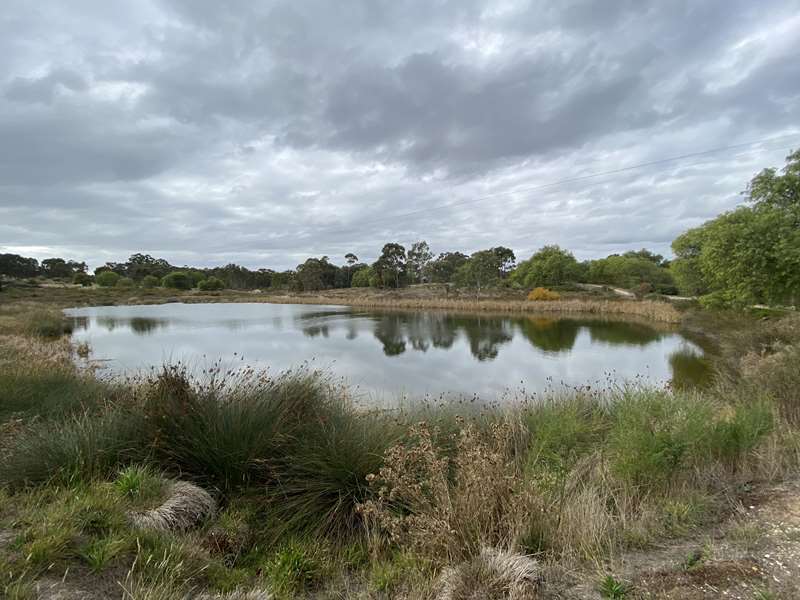Maldon - South German Mine


The South German Company began its mining career in the mid 1870s with the installation of steam-powered pumping and hauling plant. In 1886, its confidence increasing, the company erected a 20-head stamp battery, which was later increased to 30-head. In 1887, the company constructed pyrites ovens for burning the battery sand, preparatory to gold extraction. In the 1890s, the South German mine became one of the largest producers of gold in Victoria and was of great importance to the social and economic condition of Maldon.
Towards the end of the century, the mine's production began to falter. To counter the decline, in 1897 an extensive re-treatment plant was installed, using the cyanide process to extract gold from tailings (waste battery sand). The company's pioneering use of the process was stunningly successful, resulting in the retrieval of as much gold from the discarded tailings as had already been obtained by crushing and the usual gold separation processes. In 1902 the South German Company lost the shoot of gold that had provided the bulk of its ore from 1886. Up to 1902, the company had paid 336,600 pounds in dividends to shareholders; they were to receive little more as the company searched in vain for a continuation of the shoot. The mine was closed in 1918 when the shaft was flooded with water.

The South German mine site is historically significant due to its role in pioneering the use of the cyanide process in Victoria. Its treatment works was extremely profitable and influenced many other companies to adopt the process. The South German Company used a cyaniding system which was invented and patented by JJ Deeble of Bendigo. This system was to become widely used both in Australia and overseas.
J.H. Curie, in 'The Gold Mines of the World' (1899) wrote of the South German reef and the companies working it:
"Inspecting the property gave me an object lesson in the exceeding jealousy there often is between adjoining mines. The payable shoot of ore in the South German is dipping obliquely, and at about 1,800 feet - in other words at about 100 feet below the present bottom workings - it will have passed out of the South German into the South German Deep. It seems almost a certainty that this will happen, and it means that the South German is nearly worked out, and that the South German Deep has a probably big future. But the South German has a fine surface equipment, and is strong financially, while the South German Deep has no equipment and has hardly enough money to sink its shaft to the required depth. Scientific and economic mining imperatively demand an amalgamation between these two properties, and yet I found the directors of the South German refused to recognise the position, or to ask the shareholders to amalgamate, hoping that in the meantime they would starve the holders of the South German Deep into sacrificing their property. In the meantime, the older mine will be worked out, the new one will not be ready to commence working, and everyone concerned will fail to make the money that they otherwise would have made. This is called 'smart mining' in Victoria, and, indeed, in other parts of the world; but mining men did this sort of thing in the Stone Age, and thought it very smart even then .... so that we have really progressed not so very much."
And that is basically what occurred.
The most formidable relics on abandoned mining sites are usually the heavy stone/brick/concrete winding engine foundations. These had large bolts set into them which held strongly in place the steam-driven engines which rotated the large drums of steel cable used to manoeuvre the working cages of men and ore up and down the mineshafts. These winding machinery foundations typical of the 19th Century are still present at the South German site.
The job of winding machine operator was one which carried enormous responsibilities, as any small error of judgement or departure from rigorous procedure could result in injuries or death to the men underground. The driver usually faced a large dial, geared to the winch drum, upon which a moving needle showed the position of the cage in the shaft. He also had to factor in environmental variations which would cause the cables to stretch or contract, thus affecting the accuracy of the indicator dial.
Mine shafts were often divided into several working compartments. One always contained an emergency ladder in case the winding system failed.
Review:
The site has some remnants of the mine's machinery foundations. There is a short walking track down to the scenic South German Dam.
At the mine there is a shelter with two tables plus two unshaded tables and seats including some overlooking the pond.
Photos:
Location
South German Road, Maldon 3463 View Map








